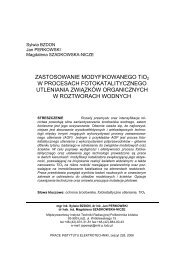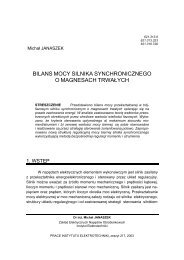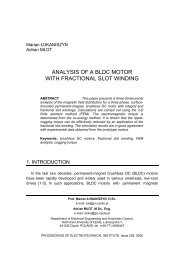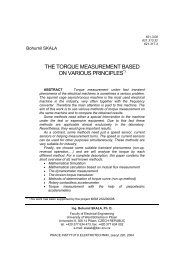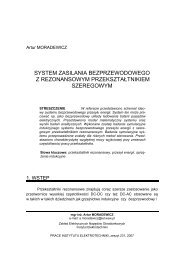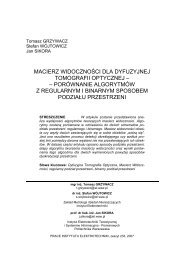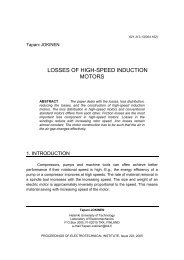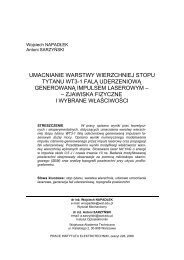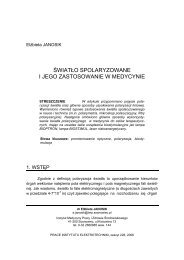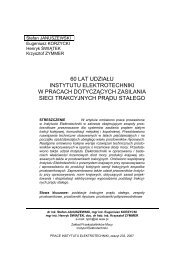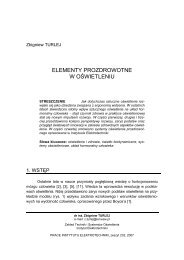representation of an induction motor in field-oriented steering ...
representation of an induction motor in field-oriented steering ...
representation of an induction motor in field-oriented steering ...
You also want an ePaper? Increase the reach of your titles
YUMPU automatically turns print PDFs into web optimized ePapers that Google loves.
Representation <strong>of</strong> <strong>an</strong> <strong><strong>in</strong>duction</strong> <strong>motor</strong> <strong>in</strong> <strong>field</strong>-<strong>oriented</strong> steer<strong>in</strong>g algorithm ... 137<br />
The experiment was executed depend<strong>in</strong>g on <strong>in</strong>troduc<strong>in</strong>g to the memory <strong>of</strong><br />
the converter two sets <strong>of</strong> parameters to describe the equivalent model <strong>of</strong> the<br />
<strong>motor</strong> <strong>in</strong> the algorithm <strong>of</strong> control. These were the follow<strong>in</strong>g parameters:<br />
calculated with the classic method procedures – Fig. 6 a) i c) <strong>an</strong>d obta<strong>in</strong>ed from<br />
identification – Fig. 6 b) i d). In Fig. 6, for example, are shown the curves<br />
acquired dur<strong>in</strong>g start<strong>in</strong>g the converter with <strong>motor</strong> SzJe-24a, with parameters<br />
counted with the classic method as well as measured dur<strong>in</strong>g the start<strong>in</strong>g<br />
procedure with parameters got from identification. Essential differences come<br />
out <strong>in</strong> the values <strong>an</strong>d time <strong>of</strong> establish<strong>in</strong>g <strong>of</strong> the magnetic flux. Differences occur<br />
also <strong>in</strong> the tr<strong>an</strong>sient processes <strong>in</strong> the <strong>motor</strong> dur<strong>in</strong>g switch<strong>in</strong>g current <strong>an</strong>d voltage<br />
models, this me<strong>an</strong>s the utilization <strong>of</strong> the sensorless vector control algorithm. In<br />
settled state however, the acquired curves are very similar to each other. If the<br />
ch<strong>an</strong>ge <strong>of</strong> schema parameters has the essential <strong>in</strong>fluence on dynamics (what<br />
we notice <strong>in</strong> shape <strong>an</strong>d time, for example, <strong>of</strong> creat<strong>in</strong>g the current component <strong>of</strong><br />
stator Isq - <strong>in</strong> consequence the torque <strong>of</strong> the <strong>motor</strong>) then it does not cause<br />
essential ch<strong>an</strong>ges <strong>in</strong> operation <strong>of</strong> the speed controller.<br />
5. CONCLUSIONS<br />
The considerations concern<strong>in</strong>g the work <strong>of</strong> a drive arr<strong>an</strong>gement with vector<br />
control steer<strong>in</strong>g algorithm give rise to the follow<strong>in</strong>g conclusion: the vector control<br />
is preferable due to the improved control characteristics e.g. accelerat<strong>in</strong>g along<br />
the current limit <strong>an</strong>d also due to the improved immunity to stall<strong>in</strong>g. Usually the<br />
vector control is also possible, even when several <strong>motor</strong>s are connected to<br />
a s<strong>in</strong>gle drive converter, as normally, the <strong>motor</strong>s are similarly loaded. On the<br />
basis <strong>of</strong> <strong>in</strong>vestigations <strong>of</strong> the model with const<strong>an</strong>t parameters <strong>of</strong> <strong><strong>in</strong>duction</strong> <strong>motor</strong><br />
<strong>in</strong> dynamic states we c<strong>an</strong> see, that its behavior is similar to the response <strong>of</strong><br />
a real <strong>motor</strong> despite accept<strong>an</strong>ce <strong>in</strong> model<strong>in</strong>g such simplifications, as the<br />
omission <strong>of</strong> hysteresis, accept<strong>an</strong>ce <strong>of</strong> perm<strong>an</strong>ent saturation <strong>of</strong> magnetic circuit<br />
as well as omission <strong>of</strong> current displacement <strong>in</strong> rotor w<strong>in</strong>d<strong>in</strong>gs for the <strong>motor</strong><br />
Sg-90L4 (differences <strong>in</strong> relation to measurements <strong>of</strong> <strong>in</strong>itial value <strong>of</strong> dynamic<br />
torque amount to about 28 % - difference <strong>in</strong> time <strong>of</strong> duration <strong>of</strong> the process is<br />
near to 0,27 s). It is good to underl<strong>in</strong>e that the area <strong>of</strong> <strong>in</strong>compatibility <strong>of</strong> <strong>in</strong>itial<br />
torque amplitudes from the po<strong>in</strong>t <strong>of</strong> view <strong>of</strong> drive perform<strong>an</strong>ce has no larger<br />
me<strong>an</strong><strong>in</strong>g because it is outside the area <strong>of</strong> limitations specified by the sett<strong>in</strong>gs <strong>of</strong><br />
functional parameters, <strong>an</strong>d also it results from different − subord<strong>in</strong>ated<br />
parameters <strong>of</strong> the drive steer<strong>in</strong>g, form<strong>in</strong>g the electromagnetic phenomena <strong>in</strong>



